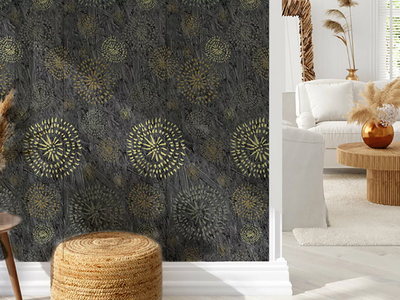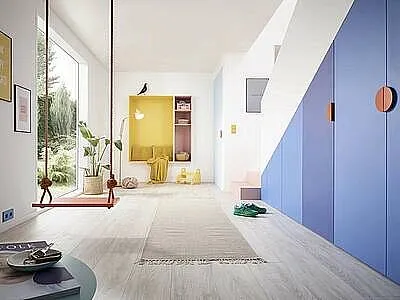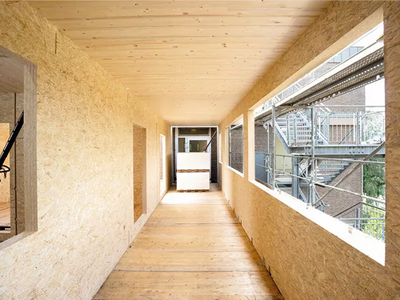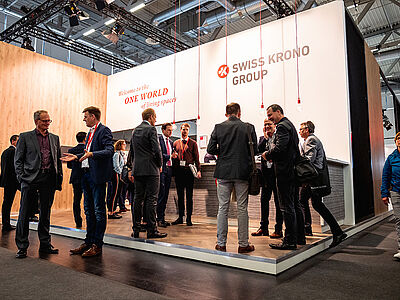Engineered Wood Products for Healthy Rooms
We spend around 90% of our time indoors, and the quality of the air we breathe there is therefore very important for our health and wellbeing. Ideally, we should breathe oxygen-rich, odourless air which is low in pollutants.
The key questions to ask for ensuring good-quality indoor air include:
- How is the room used?
- How is the building insulated?
- How is a supply of fresh air ensured?
- Which materials have been used in the building?
How a room is used naturally varies greatly. It goes without saying that there are enormous differences between rooms that are typically used by many people, possibly including smokers, and, for example, workrooms in which someone is only occasionally present.
Dense building shells take away air for breathing
There’s no doubt that modern insulation has its benefits: it reduces the amount of energy consumed for heating, minimises costs and reduces environmental burdens. The downside is that it allows only about a tenth as much air to circulate between the inside and outside of a building and therefore results in more heavily contaminated indoor air. Yet it’s vital to exchange air in order to create a healthy indoor climate and ensure the wellbeing of a building’s occupants. Every day, each of us inhales and exhales several thousand litres of air. We need about 30 cubic metres of fresh air per hour in order to feel well and fit. Unless we get it, we can have difficulty concentrating and develop headaches, irritated mucous membranes, burning eyes, insomnia, and even muscle and joint pain. Inadequate ventilation also results in increased humidity, which attracts mites and causes mildew.
Because of this, we really ought to open the windows wide for at least five minutes every two hours. Yet that is rarely practicable in everyday life, and would also cause a large share of the painstakingly accumulated indoor warmth to be lost.
Modern ventilation approaches ensure fresh air
Due to the high quality of today’s insulation, adequate modern ventilation is essential. Systems involving heat exchangers are the most efficient and eco-friendly approach. These systems extract used warm air from occupied indoor spaces and carry it outdoors. At the same time, fresh cold air from outside is warmed by the exiting air in a heat exchanger before flowing into the building’s interior – up to 85% of the heat contained in the used air is extracted and transferred to it. This automatically ensures an adequate supply of fresh air without creating any draughts or annoying noise. Some systems also monitor and fully automatically regulate the relative humidity and even include an activated charcoal filter to keep out unwanted pollen and dust.
Emission-free building materials for a healthy indoor climate
The materials used to erect a building play a crucial role in ensuring a good indoor climate. Engineered wood materials are often criticized because formaldehyde-containing binders are used to make them. SWISS KRONO therefore only uses formaldehyde-free binders to make its OSB products. As a result, its boards contain only the formaldehyde that naturally occurs in wood. This translates into emissions of just 0.01 ppm, well below the ceiling of 0.10 ppm prescribed by the European E1 regulation. These ‘natural’ emissions from wood are even lower than the formaldehyde concentrations which occur in the ambient air of some towns and cities and are considered normal. They are also less than the stricter ceiling of 0.03 ppm that various German timber construction associations are calling for (including the German Association for Prefabricated Timber Construction and the German Association for Quality in Timber Construction, Interior Finishing and Roofing). The polyurethane (PU) adhesive which is used instead is food-safe and makes it possible to keep the amount of binder contained in building materials very low. PU is all around us these days: it’s used to make car dashboards, the insulating foam in refrigerators, shoe soles and many other things. The German Federal Environment Agency (UBA), in its ‘Guideline for Indoor Hygiene in School Buildings’, concludes that the di-isocyanates used (the chemical term for PU adhesives) are chemically so thoroughly altered when producing engineered wood products that no hazards or indoor emissions are detectable. In fact, there are no indications whatsoever that OSB bonded with polymeric methylene diphenyl di-isocyanate (PMDI) releases PU or any of its precursors. In contrast to formaldehyde-containing binders, scientific institutions (including the German Federal Environment Agency, the Fraunhofer Institute for Wood Research (WKI) in Braunschweig, and EMPA in Zurich) have found no evidence that OSB products containing PU binders pose health hazards of any kind. eco-Umweltinstitut GmbH (formerly called the eco Umweltinstitut) in Cologne tested SWISS KRONO OSB to determine its methylene diphenyl di-isocyanate (MDI) emissions for the product declaration, concluding that “emissions monitoring for three days revealed that no di-isocyanate monomers were detectable.”
A large-scale study of VOC emissions (VOC = volatile organic compounds) of wood and engineered wood materials carried out by Prof. Dr Volker Mersch-Sundermann (director of the Department of Environmental Health Sciences of the Freiburg University Medical Centre) and Prof. Dr Rainer Marutzky (formerly the director of the Fraunhofer Institute for Wood Research (WKI) in Braunschweig) provided substantiated data. In an open letter published in 2010, the two experts stated that ‘regarding the occurrence of VOCs specific to wood and wood-based materials that occur in actual rooms […] no health hazards for their occupants are identifiable, especially considering that when these materials are properly installed the concentrations of specific VOCs are significantly lower than those measured in the study and also typically subside quickly. […] Although this does not prove that wood is healthy or has health-enhancing effects, it has been possible to show that no health hazards within buildings are to be expected from wood or wood-based products when these are properly installed.’
Here you can find detailed information on the OSB products available from SWISS KRONO and in the brochure presenting our entire line of OSB products which can be downloaded here.
Work contract form for testing indoor air quality
The German ‘Wood Information Service’ (Informationsdienst Holz) has published a guide (in German only) which has been used in many projects carried out by public bodies, planning bureaus and construction firms. It defines target values and test procedures and explains how to interpret measurement results.












